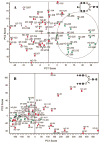Profiling of human serum glycans associated with liver cancer and cirrhosis by IMS-MS
- PMID: 18237112
- PMCID: PMC3727278
- DOI: 10.1021/pr700702r
Profiling of human serum glycans associated with liver cancer and cirrhosis by IMS-MS
Abstract
Aberrant glycosylation of human glycoproteins is related to various physiological states, including the onset of diseases such as cancer. Consequently, the search for glycans that could be markers of diseases or targets of therapeutic drugs has been intensive. Here, we describe a high-throughput ion mobility spectrometry/mass spectrometry analysis of N-linked glycans from human serum. Distributions of glycans are assigned according to their m/z values, while ion mobility distributions provide information about glycan conformational and isomeric composition. Statistical analysis of data from 22 apparently healthy control patients and 39 individuals with known diseases (20 with cirrhosis of the liver and 19 with liver cancer) shows that ion mobility distributions for individual m/z ions appear to be sufficient to distinguish patients with liver cancer or cirrhosis. Measurements of glycan conformational and isomeric distributions by IMS-MS may provide insight that is valuable for detecting and characterizing disease states.
Figures





References
-
- Hanash S. Nature. 2003;422:226–232. - PubMed
-
- Anderson NL, Anderson NG. Mol Cell Proteomics. 2002;1:845–867. - PubMed
-
- Valentine SJ, Counterman AE, Hoaglund CS, Reilly JP, Clemmer DE. J Am Soc Mass Spectrom. 1998;9:1213–1216. - PubMed
- Henderson SC, Valentine SJ, Counterman AE, Clemmer DE. Anal Chem. 1999;71:291–301. - PubMed
- Ruotolo BT, Gillig KJ, Stone EG, Russell DH. J Chromatogr, B. 2002;782:385–392. - PubMed
- Steiner WE, Clowers BH, English WA, Hill HH. Rapid Commun Mass Spectrom. 2004;18:882–888. - PubMed
- Moon MH, Myung S, Plasencia MD, Hilderbrand AE, Clemmer DE. J Proteome Res. 2003;2:589–597. - PubMed
- Valentine SJ, Liu X, Plasencia MD, Hilderbrand AE, Kurulugama RT, Koeniger SL, Clemmer DE. Expert Rev Proteomics. 2005;2:553–565. - PubMed
-
- Clemmer DE, Jarrold MF. J Mass Spectrom. 1997;32:577–592.
Publication types
MeSH terms
Substances
Grants and funding
LinkOut - more resources
Full Text Sources
Other Literature Sources
Medical

